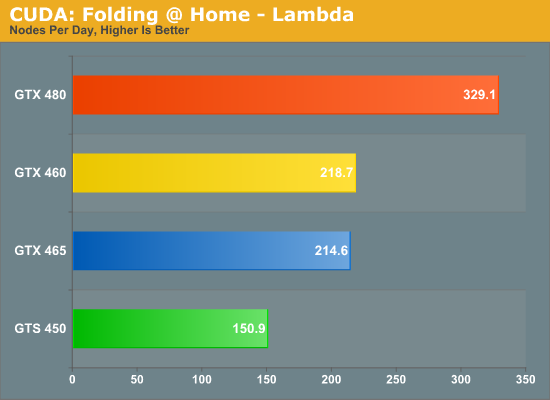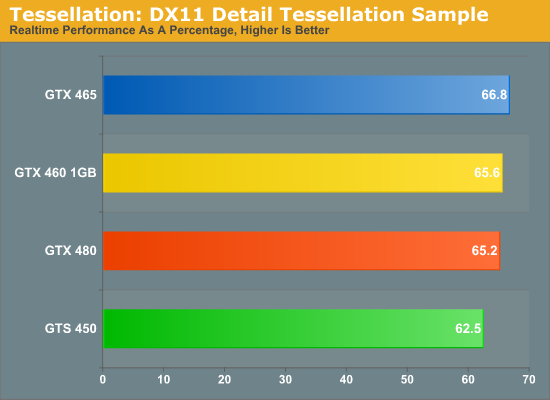NVIDIA’s GeForce GTS 450: Pushing Fermi In To The Mainstream
by Ryan Smith on September 13, 2010 12:02 AM EST- Posted in
- NVIDIA
- Fermi
- GeForce GTS 450
- GF106
- GPUs
Compute & Tessellation Performance
As we mentioned in our look at the new Forceware 260 driver set, the drivers provided by NVIDIA for our testing of the GTS 450 have a broken OpenCL component, so we had to cut our compute benchmarking short by dropping our OpenCL benchmark. Furthermore our pre-release version of Badaboom with Fermi support doesn’t work either, so that also was dropped. What we offer instead is a much more abbreviated look at the GTS 450’s compute performance.
As was the case with GF104, GF106 is a superscalar design. With 2 warp schedulers, only 2 banks of 16 CUDA cores per SM can be put in use unless NVIDIA’s hardware can extract a degree of instruction level parallelism from the resulting code. As a result all of these GF104-derrived GPUs have a wider range of compute performance than what we’re used to. At the best case scenario of being able to extract ILP every clock, we achieve peak theoretical performance. The worst case scenario is 2/3rds that performance. So the GTS 450 can perform between a 192 CUDA core and 128 CUDA core card depending on the application in use.

For our look at computing performance we once again have the CUDA version of Folding @ Home. Using the Lambda work unit, we run a short benchmark that extrapolates the number of nodes per day the card would be able to process. All things considered the GTS 450 does quite well here compared to the rest of the Fermi family thanks to its high clock speed. It may only have around 57% as many CUDA cores as the GTX 460, but the higher clockspeed means that it’s just shy of 70% of the performance. Furthermore we’ve already established that this benchmark isn’t L2 cache or memory bandwidth limited, so even though the GTS 450 isn’t using a “full” GF106 chip here, it isn’t penalized for the limitation.

Our other benchmark is a quick look at tessellation. With the DirectX 11 Detail Tessellation sample program, we’re primarily looking at whether we can throw a high enough tessellation load at the GPU to overwhelm its tessellation abilities and bring it to its knees. In this case we cannot, as the GTS 450 scales from tessellation factor 7 to tessellation factor 11 by only a little below the rate of the GTX 480 and GTX 460, achieving 63% of its performance at factor 11 . This means that the GTS 460 should still has plenty of tessellation power for even this demanding sample, but of course this is heavily dependent on how much tessellation is used by future games.
One interesting thing is that because NVIDIA built its geometry units in to its Polymorph Engines, their geometry abilities scale in a way that AMD’s doesn’t thanks to AMD’s relatively constant fixed-function pipeline in the Radeon HD 5000 series. With the GTX 480 NVIDIA was advertising an 8-fold increase in geometry performance over the GTX 285, but with the GTS 450 NVIDIA is only talking about around a 2.4x increase over the GTS 250. This neatly showcases the much wider range of geometry performance in NVIDIA’s Fermi family. It also reinforces the fact that they need developers to fully utilize tessellation in order to maximize the geometry capabilities of the GTX 480, otherwise if a card like the GTS 450 is the geometry baseline, then scaling geometry capabilities through the Polymorph Engines will not have paid off.










66 Comments
View All Comments
Ryan Smith - Monday, September 13, 2010 - link
If I had my way, we'd have every card known to man on our charts. But if I had my way, days would be 50 hours long to accommodate all of that testing...In any case not having a GTS 250 is not an oversight on our part - we simply do not have a GTS 250 to test with.
Stuka87 - Monday, September 13, 2010 - link
So it seems to me like the 450 is trying to match performance with the now year old 5770. I really think nVidia should have one upped the competition, like they did with the 460 release.I just can't see this card getting the life that nVidia needs to get out of it. AMD will do a refresh long before nVidia does, which will ultimately mean the 450 will have a very short life in comparison to the 5770.
HangFire - Monday, September 13, 2010 - link
This comment is right on the mark, and part of a disturbing trend I see with new video card generations in general and Nvidia in particular. With each new generation we are getting the same performance, more or less, at the same price points, the only difference is a newer Direct X level, lower power, or less noise, or a new video connector, etc.If all you care about is getting a certain FPS in a few games on one monitor with a certain level of AA and eye candy, the older generation cards would often be a better choice, if they were only available. Unlike in previous generations, which seemed to stay in production forever even when obsolete, the best values either go away (like the 4770 or GTX 275), get recycled at the same or higher price point (8800/9800), or get replaced by similar performance at that price point (GTS 450 vs 250).
The end result is that for a give price point, you are not buying any more Frames per Second then you were 2 years ago- unless you paid too much and made a really bad choice 2 years ago.
While at first I was thrilled to see so many older cards in this review, the GTS 250 is conspicuously absent, perhaps because it is rather embarrassing to see what little new the 450 has to offer in terms of price/performance. The 450 is not yet on Bench either, though I hope that will be remedied soon.
So, congratulations Nvidia, you now have a more complete DirectX 11 lineup, but you've offered me nothing in price/performance to make me want to replace any of my DirectX 10 cards.
just4U - Monday, September 13, 2010 - link
I disagree. Annand put up numbers for the 4850 which has always pretty much walked allover the GTX250 (9800GTX 8800GTX etc) Looking at the graphs the 450 is somewhat faster so including the 250 benchmarks is not neccessary.Also, Both Ati and Nvidia seem to be in a holding pattern as far as performance goes with their current lineups. People upgrading from the latest and greatest from the last generation of video cards won't notice huge gains performance wise. What they will notice (depending on the card) is lower temperatures, less power consumption, and ofcourse more features.
Those upgrading from cards 2+ years old or value oriented cards from the last generation are likely to see the most gains overall with these new ones. The rest of us get a sideways upgrade at best. Atleast thats my opinion anyway.
geniekid - Monday, September 13, 2010 - link
I must also disagree, respectfully. A couple of the benchmarks here show that for less than half the price I paid for my top-of-the-line factory OCed 9800GTX several years ago, I can get about the same or slightly better performance. This shows me that progress is being made - or, at the very least, that price/performance is improving over time.HangFire - Monday, September 13, 2010 - link
Wow, thanks for the respect in the disagreement! But then, this is AT not Tom's.Speaking of Tom's, I just read their GTS450 review, and their statement after the DX9-10 benchmarks (CoD:MW2 and Crysis) mirrors mine vis-a-vis the GTS 250- "Naturally, numbers like this don’t compel you to upgrade." While another site quoted 20-25% better performance, Tom's had the 250 faster than the 450.
I would expect a three generation old top-of-the-line card to have poor value compared to a mainstream card of today. (I say three because a 9800 GTX OC is essentially an 8800 Ultra). Nvidia complicates the issue with generational recycling and the missing GTX 3xx DirectX 10.1 cards that never existed. I'm trying to compare like-to-like, that is mainstream cards in the $140 to $150 range (price at introduction).
If you look at the incremental performance differences of the mid-stream cards 8800GT->9800GT->GTS 250->GTS 450, anyone that actually bought each of these cards for $130->$150 expecting a big generational performance boost with each jump was sorely disappointed. On the AMD side things are a little better, but the mainstream level 4xxx to 5xxx jump was more about power and Eyefinity than performance. (Of course their top-end cards made big jumps, at big $$$).
The new GTS 450 is launched at the same price point the GTS 250 had, and offers very similar performance. Of course, the 250 dropped in price like a stone, because it had to, and the 450 may have some adjustments ahead of it. But let's say it was 25% faster across the board, is it compelling? The 7800GT to 8800GT upgrade, now that was compelling.
just4U - Monday, September 13, 2010 - link
You have to remember something though.. the 8800 line was a new standard by which all cards are/were measured by. Like the Radeon 9700/800 it takes years to move past it... We do not see those crazy bumps in performance and features happen often afterall.IceDread - Monday, September 13, 2010 - link
"The GTX 460 was a card that made the comparable AMD card obsolete and brought significantly improved performance to the $200 market. NVIDIA had a card built to hit one of AMD’s weak spots, and it struck beautifully. "A news site should strive towards being unbiased but anandtech sure does not do that.
just4U - Monday, September 13, 2010 - link
Have you had the oportunity to use the 460? Or the 5830/50 that it competes against? Anandtech hit the nail on the head with that statement and it's not based upon Ati/Nvidia bias. Simply put it's one of the best buys on the market right now and with all of Nvidia's misteps it's surprising to see them come out with a card that is so hard to pick fault with.heflys - Monday, September 13, 2010 - link
Yeah, the GTX 460 1gb made the 5830 obsolete, but the 768mb version sure didn't. And the 5850 has started to come down in price, and you can now pick it up for $259 after rebate.